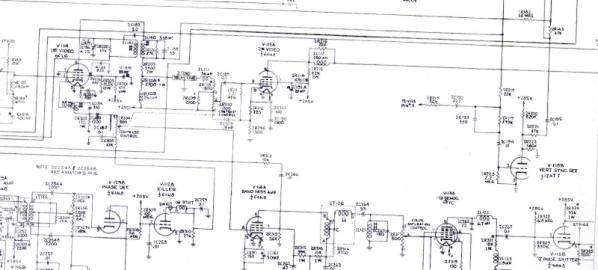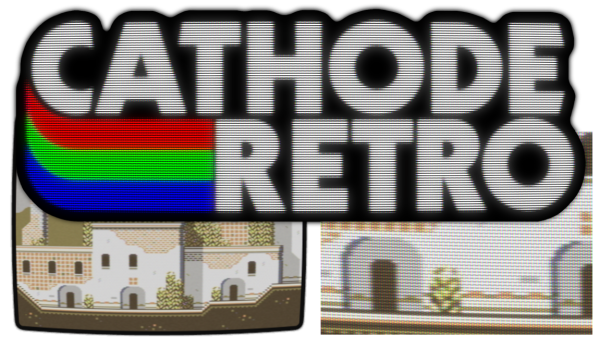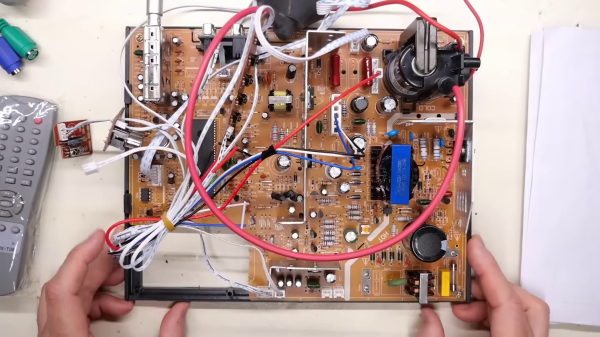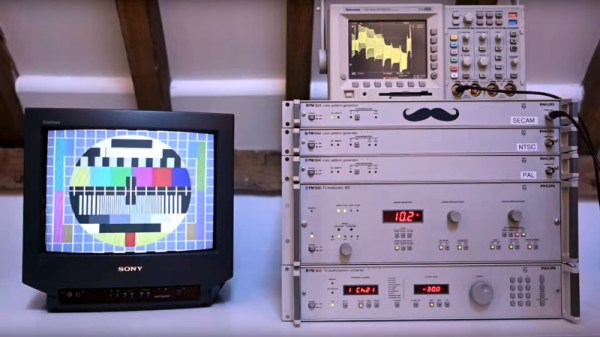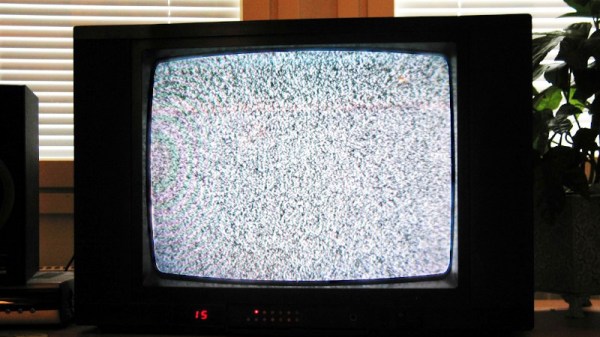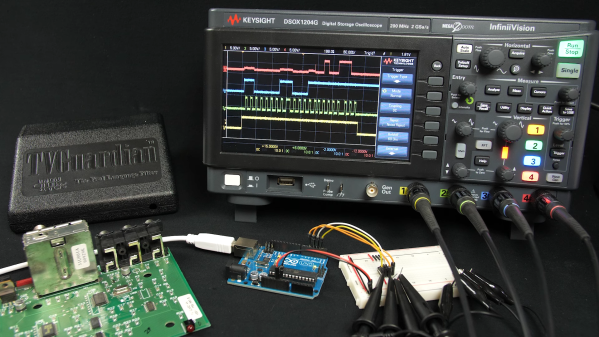After a quiet week in the news cycle, surveillance concern Flock jumped right back in with both feet, announcing a strategic partnership with Amazon’s Ring to integrate that company’s network of doorbell cameras into one all-seeing digital panopticon. Previously, we’d covered both Flock’s “UAVs as a service” model for combating retail theft from above, as well as the somewhat grassroots effort to fight back at the company’s wide-ranging network of license plate reader cameras. The Ring deal is not quite as “in your face” as drones chasing shoplifters, but it’s perhaps a bit more alarming, as it gives U.S. law enforcement agencies easy access to the Ring Community Request program directly through the Flock software that they (probably) already use.
ntsc43 Articles
The Long Strange Trip To US Color TV
We are always fascinated when someone can take something and extend it in a clever way without changing the original thing. In the computer world, that’s old hat. New computers improve, but can usually run old software. In the real world, the addition of stereo to phonograph records and color to photography come to mind.
But there are few stories as strange or wide-ranging as the path to provide color TV. And it had to be done in a way that a color set could still get a black and white picture and black and white sets could still watch a color signal without color. You’d think there would be a “big bang” moment where color TV burst on the scene — no pun involving color burst intended. But there wasn’t. Instead, there was a long, twisted path with many competing interests and ideas to go from a world in black and white to one tinted with color phosphor.
Background
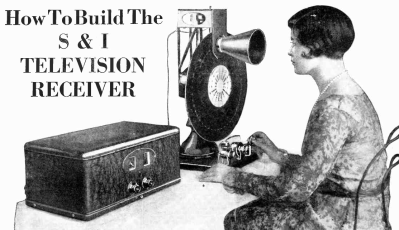
It is hard to imagine, but John Logie Baird transmitted color images as early as 1928 using a mechanical scanner. Bell Labs had a demonstration system, also mechanical, in 1929. Baird broadcast using his system in 1938. Even earlier, around 1900, there were attempts to create mechanical color image systems. Those systems were fickle or impractical, though.
Electronic scanning was the answer, but World War II froze most consumer electronics development. Baird showed an electronic color system in late 1944. However, it would be 1953 before NTSC (the National Television System Committee) adopted the standard color TV signal for the United States. It would be almost 20 years later before SECAM and PAL were standardized in other parts of the world.
Of course, these are all analog standards. The world’s gone digital now, but for nearly 50 years, analog color TV was the way people consumed TV in their homes. By 1941, NTSC produced a standard in the United States, but not for color TV. TV adoption didn’t really take off until after the war. But by 1950, the US had some 6 million TV sets.
This was both a plus — a large market — and a negative. No one wanted to obsolete those 6 million sets. Well, at least, the government regulators and consumers didn’t. But most color systems would be incompatible with those existing black and white sets. Continue reading “The Long Strange Trip To US Color TV”
Bringing Back The CRT TV Experience In Software
Cathode-Retro is a collection of shaders and sample C++ code for reliving the glorious days when graphics were composite video signals displayed on a CRT screen. How? By faking it in software and providing more configuration options than any authentic setup ever had.
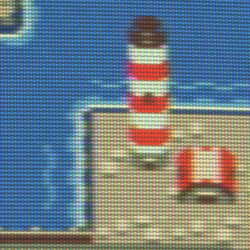
Not satisfied with creating CRT-style color images with optional scanlines and TV picture controls like tint and saturation, Cathode-Retro can emulate more nuanced elements as well.
The tool includes the ability to imitate things like the slight distortion of a period-correct curved screen, the subtle effects of different methods CRT displays used to actually work (such as shadow mask vs aperture grille), and even taking into account the slight distortion of light refracting imperfectly through the glass face of the CRT. There’s even options for adding noise and ghosting, which may spark some artistic ideas.
If all you need is software to recreate an old-school CRT terminal, we have you covered. But if your needs are a bit more low-level, Cathode-Retro might be what you’re missing.
New Motherboard Improves Old CRT Television
While browsing AliExpress from his digital basement, [Adrian Black] stumbled upon what seemed like a brand-new mainboard for a CRT television set. He decided to take a gamble and ordered one. It finally arrived, and was indeed a brand new product from 2023.
DIGITAL MAIN BOARD OF TV, Work ath [sic] HONGXUN products with the care and precision of a sculptor in each step, wonderful have no limits
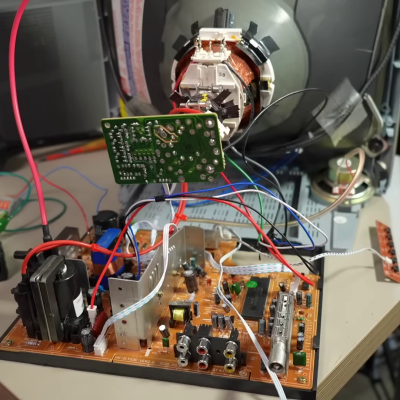
Dubious marketing descriptions like “High Definition Digital Color TV Driver Board” aside, this turned out to be a fairly well-designed analog TV board. [Adrian] pulls a 20-year-old Magnavox ( Philips ) color television set from storage and begins the transplant operation. One interesting observation is the Magnavox board has almost the same layout as the new board, except for the orientation of the sections. The new CRT neck board had a different connector than the Magnavox set, but was designed to accept multiple sized sockets. [Adrian] just removed the new socket and replaced it with one from the old set. The mechanical issues were a bit more complicated, but nothing that a Dremel tool and a bit of hot glue can’t fix. The 220 VAC power supply was eventually modified to accept 110 VAC, which also enabled him to reconnect the degaussing coil.
[Adrian] has collected some relevant documentation in this GitHub repository, including schematics. Why bother with this at all? Well, until now, he didn’t have any way to test / view PAL RF signals in his lab. He was gambling on the new mainboard having a PAL tuner. It does, but as an unadvertised bonus, it supports NTSC and SECAM as well — but still not “HD digital color TV”, as far as we know. If you want a multi-standard TV in your lab, this solution may be worth considering. It appears there is still a market somewhere for new CRT televisions. If you have any background on this, please let us know down below in the comments.
Continue reading “New Motherboard Improves Old CRT Television”
System Essentially Contradicting American Methods
Today, acronyms such as PAL and initialisms such as NTSC are used as a lazy shorthand for 625 and 525-line video signals, but back in the days of analogue TV broadcasting they were much more than that, indeed much more than simply colour encoding schemes. They became political statements of technological prowess as nations vied with each other to demonstrate that they could provide their citizens with something essentially home-grown. In France, there was the daddy of all televisual symbols of national pride, as their SECAM system was like nothing else. [Matt’s TV Barn] took a deep dive into video standards to find out about it with an impressive rack of test pattern generation equipment.
At its simplest, a video signal consists of the black-and-while, or luminance, information to make a monochrome picture, along with a set of line and frame sync pulses. It becomes a composite video signal with the addition of a colour subcarrier at a frequency carefully selected to fall between harmonics of the line frequency and modulated in some form with the colour, or chrominance, information. In this instance, PAL is a natural progression from NTSC, having a colour subcarrier that’s amplitude modulated and with some nifty tricks using a delay line to cancel out colour shifting due to phase errors.
SECAM has the same line and frame frequency as PAL, but its colour subcarrier is frequency modulated instead of amplitude modulated. It completely avoids the NTSC and PAL phase errors by not being susceptible to them, at the cost of a more complex decoder in which the previous line’s colour information must be stored in a delay line to complete the decoding process. Any video processing equipment must also, by necessity, be more complex, something that provided the genesis of the SCART audiovisual connector standard as manufacturers opted for RGB interconnects instead. It’s even more unexpected at the transmission end, for unlike PAL or NTSC, the colour subcarrier is never absent, and to make things more French, it inverted the video modulation found in competing standards.
The video below takes us deep into the system and is well worth a watch. Meanwhile, if you fancy a further wallow in Gallic technology, peer inside a Minitel terminal.
Continue reading “System Essentially Contradicting American Methods”
Encoding NTSC With Your Hands Tied
Generally, when trying to implement some protocol, you are constrained by your hardware and time. But for someone like [EMMIR], that’s not enough. For example, NTSC-CRT is a video signal encoding/decoding simulator with no hardware acceleration, floating point math, or third-party libraries. Just basic C.
While NTSC has officially gone dark in America, people still make their own ATTiny-powered transmitters. NTSC is a bit of a strange standard and is sometimes referred to as never-twice-the-same color, but it does produce a distinct look.
That look is what [EMMIR] was going for. It encodes a message in a ppm format into NTSC and then back in ppm with some configurable noise. It can do this in real-time as an effect in [EMMIR’s] engine or on a rendered image via a CLI. It looks incredible, and there’s something very satisfying. There’s a video after the break showing off the effect. The code is pretty short and easy to read.
Reverse Engineering “The Seven Words (and More) You Can’t Say On TV”
For as visionary as he was, [George Carlin] vastly underestimated the situation with his classic “Seven Words You Can’t Say on TV” bit. At least judging by [Ben Eater]’s reverse engineering of the “TVGuardian Foul Language Filter” device, it seems like the actual number is at least 20 times that.
To begin at the beginning, a couple of weeks ago [Alec] over at everyone’s favorite nerd hangout Technology Connections did a video on the TVGuardian, a device that attempted to clean up the language of live TV and recorded programming. Go watch that video for the details, but for a brief summary, TVGuardian worked by scanning the closed caption text for naughty words and phrases, muted the audio when something suggestive was found in a lookup table, and inserted a closed caption substitute for the offensive content. In his video, [Alec] pined for a way to look at the list of verboten words, and [Ben] accepted the challenge.
The naughty word list ended up living on a 93LC86 serial EEPROM, which [Ben] removed from his TVGuardian for further exploration. Rather than just plug it into a programmer and dumping the contents, he decided to roll his own decoder with an Arduino, because that’s more fun. And can we just point out our ongoing amazement that [Ben] is able to make watching someone else code interesting?
The resulting NSFW word list is titillating, of course, and the video would be plenty satisfying if that’s where it ended. But [Ben] went further and figured out how the list is organized, how the dirty-to-clean substitutions are made, and even how certain words are whitelisted. That last bit resulted in the revelation that Hollywood legend [Dick Van Dyke] gets a special whitelisting, lest his name becomes sanitized to a hilarious [Jerk Van Gay].
Hats off to [Alec] for inspiring [Ben]’s fascinating reverse engineering effort here.
Continue reading “Reverse Engineering “The Seven Words (and More) You Can’t Say On TV””


